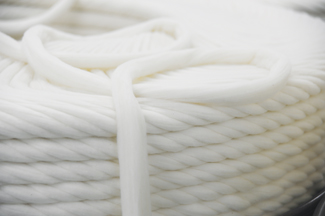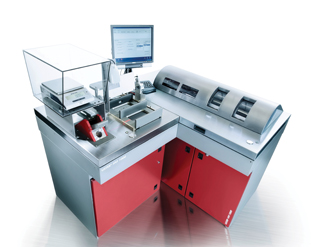As worldwide stocks of cotton continue to build up, spinners might eagerly be anticipating a period of lower prices for their raw material. But there are serious risks ahead, particularly when the market is likely to be flooded with some cotton that has been stored in warehouses for lengthy periods.
The cotton quality issue was raised for the first time at the last International Textile Manufacturers Federation’s Conference in Beijing, and then again at the International Cotton Advisory Committee’s Plenary Meeting in Thessaloniki, Greece. In Beijing, Gao Fang, head of the China Cotton Association, presented a China cotton market analysis and outlook on the purchase policy of China for cotton during the 2011-13 seasons. Gao said that China is holding a stock of more than 10 million metric tons of cotton.
The cotton quality issue has been discussed by Switzerland-based Uster Technologies, a manufacturer of instruments for textile quality measurement and certification such as testing and monitoring instruments, systems, and services that allow optimization of quality through each individual stage of textile production. This includes raw fibers, such as cotton or wool, all man-made staple fiber and filament yarns, as well as downstream services to the final finished fabric. Uster reports that accurate testing with the Uster HVI 1000 is the only guaranteed way to check that cotton supplies are fit for purpose.
Prices on world cotton markets look set to fall against a background of inventory levels that have risen massively in recent years. It is estimated that more than 100 million bales currently are stored in warehouses around the world — a stockpile that would supply the whole textile industry for a year. China alone has more than half of this total inventory, at 62 million bales, which would be enough for two years of domestic textile needs.

The longer cotton is kept in storage and the less favorable the warehousing conditions, the quicker and more severe the loss of color grade.
Cotton growers are bound to cut back outputs as demand falls and the cotton supply chain starts destocking on a large scale. If a glut of lower-priced cotton hits the market, it could be a favorable position for spinners. However, the situation is probably not so favorable. One must not forget the ancient Roman maxim: Caveat Emptor — Buyer Beware.
Storage Effect On Cotton Quality
A big problem likely centers on how long the cotton stocks have been warehoused, and under what conditions. It is an acknowledged fact that raw cotton quality declines over time, even when stored in excellent conditions. The major issue is loss of color grade, often referred to as yellowing, and it is not always readily apparent without proper testing. Cotton may emerge from the gin and head to the warehouse with excellent quality ratings recorded and tagged at this point. But, over time, color degradation will take its toll on the quality level, especially when the cotton is warehoused for long periods.
Special attention should be paid to cotton sourced from areas with enormous stockpiles, where storage options often are poor, with farmers keeping cotton loose in sheds, exposed to changing environmental conditions and moisture — a clear quality risk.
In the near future, there will be actions to balance mill consumption with cotton production in China. One way will be to cut back on imports, so that domestic mills will buy warehoused supplies. However, what happens, asked Uster, if Chinese spinners are aware that this cotton may have been in the warehouse for as long as three years? They might balk at the potential quality risks.
Careful Testing A Necessity
If Chinese spinners reject the warehoused cotton, some of this questionable stock may be thrown into the world market spreading the risks to spinners everywhere. Customers who purchase cotton that has been in long-term storage almost certainly will not be able to rely on the quality data tagged on the bales. And this can affect the value — the price paid may be higher than the cotton really is worth — as well as the quality performance of the cotton through yarn production and into the finished fabric. Careful testing of incoming cotton for key quality parameters is vital if spinners are to avoid these potentially serious problems from damaging their business prospects.
How Important Is Color Grade?
Color grade is a key driver of raw cotton pricing, and always is an issue in buying and selling negotiations because a number of serious fabric faults can be traced back to color grading issues. It is essential that spinners know exactly the correct color data for every cotton purchase. With this data, they can be certain that blending bales at the start of the spinning process is appropriate for the yarn quality being produced.
Extensive testing of color degradation of cotton under various environmental conditions has resulted in clear evidence of the seriousness of the problem. The longer that cotton is in storage and the worse the warehousing conditions, the quicker and more severe will be the loss of color grade. Even in ideal storage environments, cotton that is kept for more than a year will start to degrade. If conditions are unsuitable, such as in a hot and humid warehouse, Uster reports that yellowing can occur within six weeks.
The Impact On Spinners
Most spinners will be fully aware of the risk of color grade loss with cotton that has been in long-term storage. Though, the effect of the storage conditions on this problem is less widely known. Still, it may often be impossible for spinners to check on the detailed warehousing environment of the purchased cotton.
What spinners realize all too well is that yarn quality can be drastically affected by inaccurate color grade data. The defect known as barré, is an unwanted striping effect in woven or knitted fabrics, which becomes visible only during fabric production or during dyeing. The barré effect can be caused directly by inaccurate color grade data, often taken from outdated bale tags. One has to bear in mind that quality tags on the bales are only completely valid at the time of its issue. Spinners can be faced with costly quality claims and a loss of reputation as a result of this one issue.

Uster’s HVI 1000 is a globally accepted instrument with its own standards used for effective cotton classing and accurate testing.
“Relying on data that does not represent the current quality of the cotton results in unavoidable issues of unforeseen enormity, with repercussions along the entire textile value chain in terms of both quality and profitability — and spinners will be the ones in the firing line,” said David McAlister, product manager, Cotton Classing, Uster Technologies.
Effective Cotton Classing
The solution for spinners is effective cotton classing — retesting raw cotton samples before making a purchase decision. For this task, the Uster HVI 1000 is the globally-accepted instrument used to set cotton calibration standards by the world’s leading cotton authorities, including the U.S. Department of Agriculture, China Fiber Inspection Bureau and many other national bodies. The HVI provides fast and accurate data on color grade levels, so spinners can compare quality data from bale tags with their own test results. Not only does it give them security that their cotton purchase is good value, it also helps to determine the optimum mix of qualities at the start of the spinning process.

“The Uster HVI 1000 will not only prevent pricing and quality problems, it will also provide a rapid payback on the initial investment in the system,” said McAlister. “It will give spinners confidence that the yarn quality they are producing will be exactly what their customers have ordered.”
McAlister referenced a 2002 Cotton Incorporated study that illustrated the financial impact of the barré problem and the possible cost savings realized when the HVI 1000 is used. According to McAlister, the study showed that producing fabric with barré defects costs about 21,400 euros ($27,000) for every 1,818 kilograms (kg) (4,000 pounds) of fabric. Therefore, a typical 50,000-spindle mill, producing 30,000 kg of standard-count yarn per day, would lose 400,000 euros ($500,000) every day. Purchasing a HVI 1000 instrument is a small investment compared to the potential losses incurred when the cotton quality is unknown.
“Rising worldwide yarn quality requirements and the realistic risks from long-term raw cotton stocks cannot be ignored,” stated McAlister. “There could be a serious impact on world markets for many years to come. But the situation also presents an opportunity for smart spinners who can deliver consistent yarn quality levels supported by accurate raw material testing.”
April/May/June 2015
